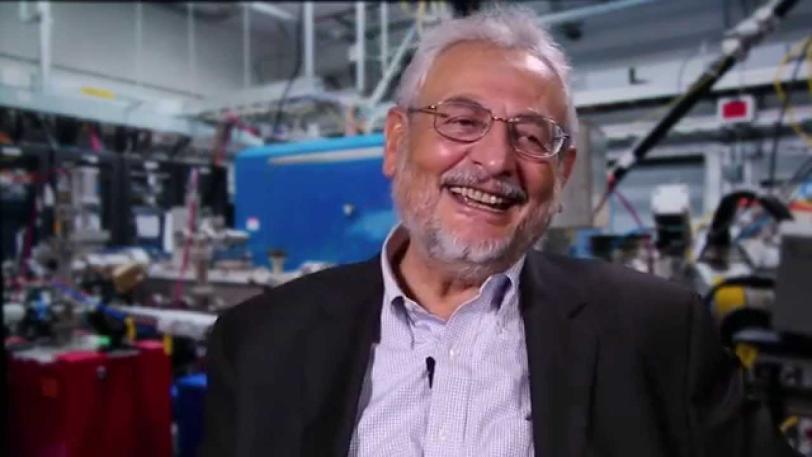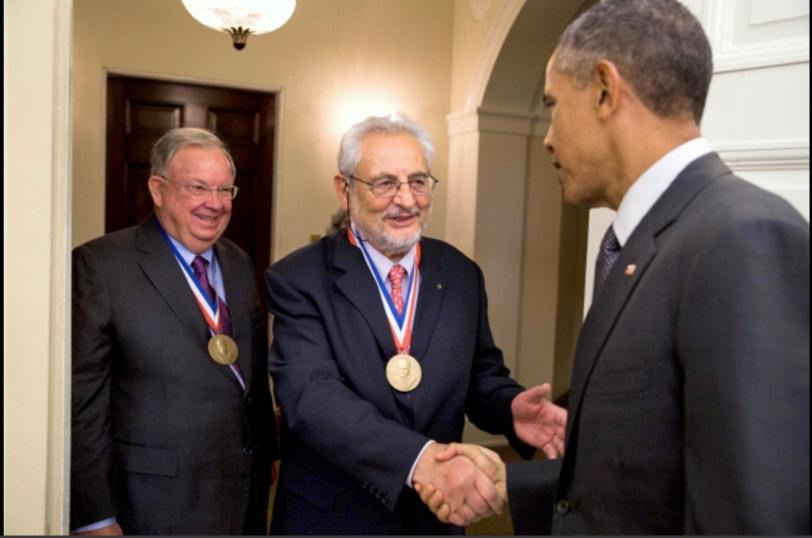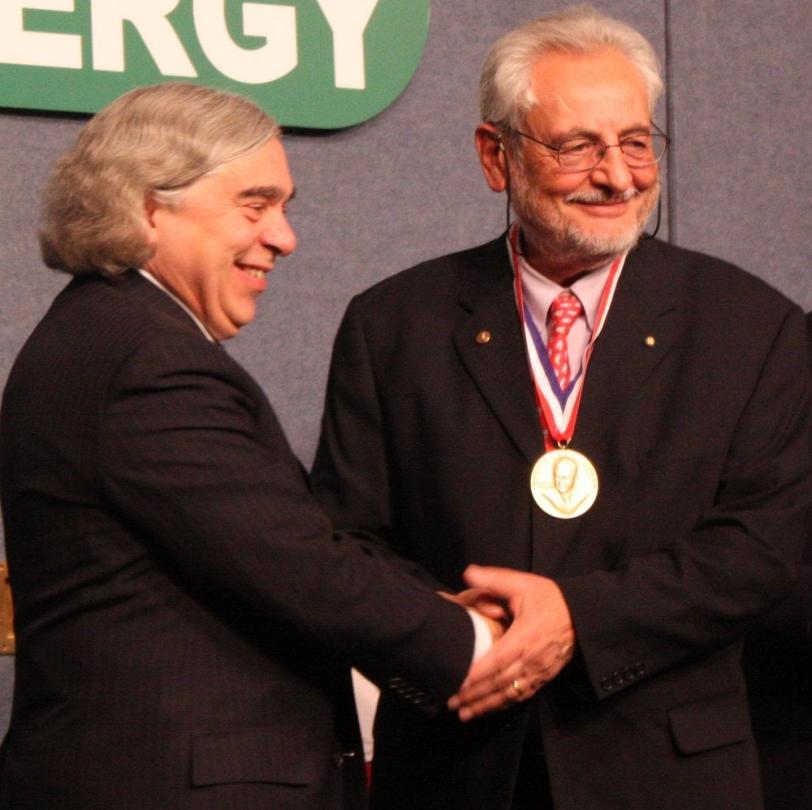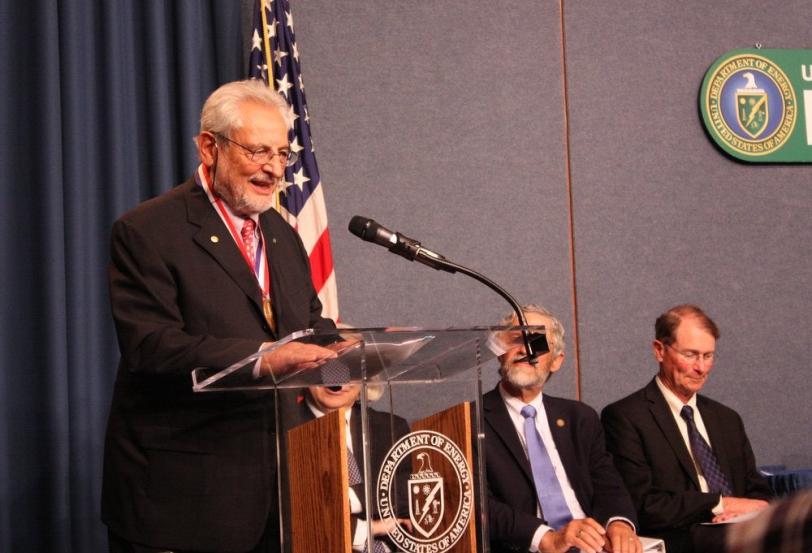SLAC's Claudio Pellegrini Receives Fermi Award at White House
X-ray Laser Science Pioneer Honored for Work that Laid the Foundation for SLAC’s Linac Coherent Light Source
President Obama welcomed SLAC National Accelerator Laboratory's Claudio Pellegrini into the Oval Office Tuesday morning as a recipient of the Enrico Fermi Award, one of the highest honors the U.S. government can give to a scientist.
Pellegrini, a visiting scientist and consulting professor at SLAC and distinguished professor emeritus at the University of California, Los Angeles, received the award for research that aided in the development of X-ray free-electron lasers (XFELs) including SLAC's Linac Coherent Light Source (LCLS), a DOE Office of Science User Facility that started up in 2009.
Charles V. "Chuck" Shank, director emeritus of Lawrence Berkeley National Laboratory and senior fellow with the Howard Hughes Medical Institute, shared this year’s Fermi Award with Pellegrini and also met with the president Tuesday. Shank is honored for contributions to ultrafast science and energy research, his leadership of national scientific and engineering communities and his service in advancing the national laboratories.

"The president opened the door and greeted us," Pellegrini said. "He asked Chuck Shank and me about what we have done. He was interested in what we could do with an XFEL, with the science and the applications."
Pellegrini said he explained how XFELs have broad uses in studying materials science, biology, physics and chemistry. "We had a tour of the White House before going to the Oval Office. It was a great visit," Pellegrini said.
Energy Secretary Ernest Moniz also attended, as did Pellegrini’s wife, Maria Grazia, who got an unexpected hug from the president and was deeply moved. “He made my day,” she said.
Pellegrini's and Shank's scientific achievements were celebrated in a separate Fermi Award ceremony Tuesday evening at the U.S. Department of Energy headquarters in Washington, D.C. Two of Pellegrini’s children, five grandchildren and his sister from Italy also attended the ceremony.

Claudio Pellegrini and the World’s First Hard X-ray Free-electron Laser
The presidential award was first presented in 1956 to honor the memory of Nobel laureate Enrico Fermi, a pioneer in the field of nuclear and particle physics. It recognizes distinguished achievement, leadership and service related to all basic and applied research, science and technology supported by the DOE and its programs. Recipients receive a gold medal and share an honorarium of $50,000. SLAC Director Emeritus Burton Richter, a Nobel Prize winner, received the 2010 Fermi Award.
Pellegrini's work was key in establishing a new concept for how to wiggle bunches of electrons with powerful alternating magnetic fields to give off X-ray light and then greatly amplify the light pulses. The process, known as “self-amplified spontaneous emission” or SASE, creates ultrabright X-ray laser pulses at LCLS. Its pulses are about a billion times brighter than those achieved by its predecessors, and can explore matter at the scale of atoms and ultrafast processes that are measured in femtoseconds, or quadrillionths of a second. Since LCLS opened, other XFELs have started up in Japan and Italy, and others are under construction in Europe, South Korea and Switzerland.
Pellegrini credited the combined effort of many people at SLAC and beyond for the Fermi Award he received.
"This is a recognition for many,” he said. “The idea is something, but when you want to build an instrument as complicated as LCLS and use it for experiments, you need everyone to work together. That's why you need a big lab with technical capabilities like SLAC.”
Pellegrini said he looks forward to progress at LCLS and other XFELs, including a planned upgrade and expansion of LCLS, known as LCLS-II, with new capabilities, such as a faster rapid-fire pulse rate and a higher peak power, that should open up new fields of study.
"Already XFELs are very developed in many areas, and I think there is more to do," he said. "Part of this will come with LCLS-II."
Contact
For questions or comments, contact the SLAC Office of Communications at communications@slac.stanford.edu.
SLAC is a multi-program laboratory exploring frontier questions in photon science, astrophysics, particle physics and accelerator research. Located in Menlo Park, Calif., SLAC is operated by Stanford University for the U.S. Department of Energy's Office of Science.
SLAC National Accelerator Laboratory is supported by the Office of Science of the U.S. Department of Energy. The Office of Science is the single largest supporter of basic research in the physical sciences in the United States, and is working to address some of the most pressing challenges of our time. For more information, please visit science.energy.gov.









